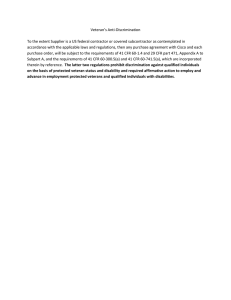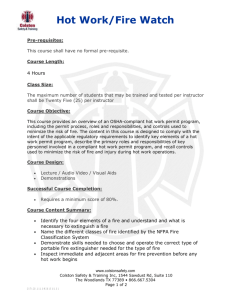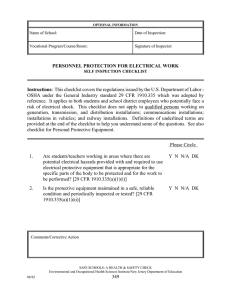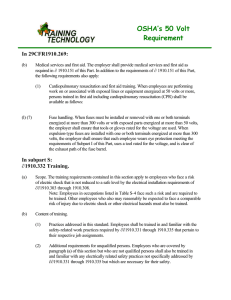check53 - Rutgers School of Public Health
advertisement
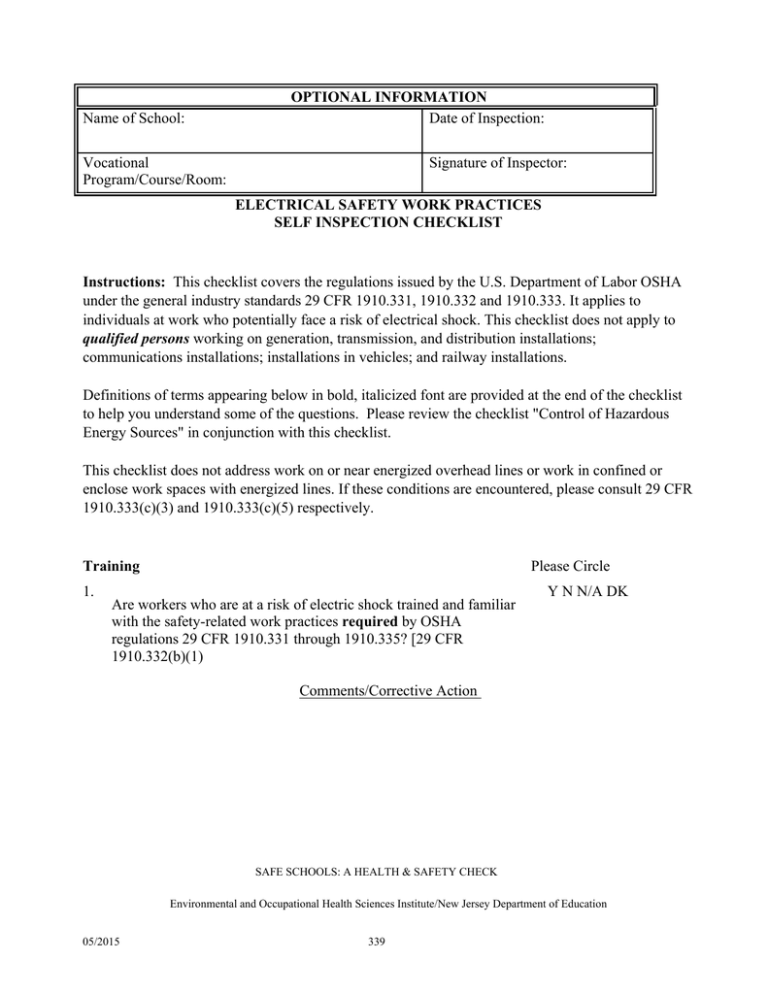
Name of School: OPTIONAL INFORMATION Date of Inspection: Vocational Program/Course/Room: Signature of Inspector: ELECTRICAL SAFETY WORK PRACTICES SELF INSPECTION CHECKLIST Instructions: This checklist covers the regulations issued by the U.S. Department of Labor OSHA under the general industry standards 29 CFR 1910.331, 1910.332 and 1910.333. It applies to individuals at work who potentially face a risk of electrical shock. This checklist does not apply to qualified persons working on generation, transmission, and distribution installations; communications installations; installations in vehicles; and railway installations. Definitions of terms appearing below in bold, italicized font are provided at the end of the checklist to help you understand some of the questions. Please review the checklist "Control of Hazardous Energy Sources" in conjunction with this checklist. This checklist does not address work on or near energized overhead lines or work in confined or enclose work spaces with energized lines. If these conditions are encountered, please consult 29 CFR 1910.333(c)(3) and 1910.333(c)(5) respectively. Please Circle Training 1. Are workers who are at a risk of electric shock trained and familiar with the safety-related work practices required by OSHA regulations 29 CFR 1910.331 through 1910.335? [29 CFR 1910.332(b)(1) Y N N/A DK Comments/Corrective Action SAFE SCHOOLS: A HEALTH & SAFETY CHECK Environmental and Occupational Health Sciences Institute/New Jersey Department of Education 05/2015 339 2. Are qualified workers (those who are permitted to work on or near exposed energized parts) given the following training? a) The skills and techniques necessary to distinguish exposed live parts from other parts of electric equipment; b) The skills and techniques necessary to determine the nominal voltage of exposed live parts; and c) The clearance distances specified in Table 1 and the corresponding voltages to which the qualified person will be exposed? [29 CFR 1910.332(b)(3)] Y N N/A DK Table 1 Minimum Distance for Voltage Ranges Voltage Range (phase to phase) 300V and less Over 300V, not over 750V Over 750V, not over 2kV Over 2kV, not over 15kV Over 15kV, not over 37kV Over 37kV, not over 87.5kV Over 87.5kV, not over 121kV Over 121kV, not over 140kV Required Minimum Distance Between Individuals and Exposed Energized Parts Avoid Contact 1 ft. 0 in. ( 30.5 cm) 1 ft. 6 in. ( 46 cm) 2 ft. 0 in. ( 61 cm) 3 ft. 0 in. ( 91 cm) 3 ft. 6 in. (107 cm) 4 ft. 0 in. (122 cm) 4 ft. 6 in. (137 cm) 3. Is the degree of training provided determined by the risk to the person? [29 CFR 1910.332(c)] Y N N/A DK Comments/Corrective Action SAFE SCHOOLS: A HEALTH & SAFETY CHECK Environmental and Occupational Health Sciences Institute/New Jersey Department of Education 05/2015 340 Selection and Use of Work Practices 4. Are current employees trained every three years as part of an electrical safety program? [NFPA 30] Y N N/A DK 5. Are all live parts de-energized before workers can work on Y N N/A DK them unless deenergizing increases the hazards or is not possible because of equipment design or operational limitations? [29 CFR 1910.333(a)(1)] Note: Live parts that operate at less than 50 volts to ground do not need to be deenergized if they do not increase exposure to electrical burns or to explosion due to electrical arcs. 5. If live parts are not de-energized, are work practices used to protect workers who may be exposed to electrical hazards? [29 CFR 1910.333(a)(2)] Y N N/A DK 6. If live parts are not de-energized, do work practices protect the body against direct contact with energized parts and against indirect contact through a conductive object? [29 CFR 1910.333(a)(2)] Y N N/A DK Working On or Near Exposed De-energized Parts 7. If a worker is exposed to contact with parts of fixed electrical equipment or circuits that have been de-energized, have the circuits energizing the parts been locked and/or tagged? [29 CFR 1910.333(b)(2)] Y N N/A DK 8. Is there a written copy of electrical safety procedures (including lockout and tagging) available for inspection? [29 CFR 1910.333(b)(2)(i)] Y N N/A DK Comments/Corrective Action 9. Are safe procedures determined before circuits or equipment get de-energized? [29 CFR 1910.333(b)(2)(ii)(A)] Y N N/A DK SAFE SCHOOLS: A HEALTH & SAFETY CHECK Environmental and Occupational Health Sciences Institute/New Jersey Department of Education 05/2015 341 10. Are the circuits and equipment to be worked on disconnected from all energy sources? [29 CFR 1910.333(b)(2)(ii)(B)] Y N N/A DK Note: Control circuit devices, such as push buttons, selector switches and interlocks, may not be used as the sole means for de-energizing circuits or equipment. Interlocks for electric equipment may not be used as a substitute for lockout and tagging procedures. 11. 12. Has stored electric energy that might endanger workers been released? [29 CFR 1910.333(b)(2)(ii)(C)] Y N N/A DK Note: Capacitors shall be discharged. If the stored electric energy might endanger personnel, high capacitance elements shall be short-circuited and grounded. Is stored non-electrical energy in devices that could Y N N/A DK reenergize electric circuit parts blocked or relieved to the extent that the circuit parts could not be accidentally energized by the device? [29 CFR 1910.333(b)(2)(ii)(D)] 13. Is a lock and tag placed on each disconnecting means Y N N/A DK used to deenergize circuits and equipment? [29 CFR 1910.333(b)(2)(iii)(A)] 14. Is the lock attached so as to prevent anyone from operating Y N N/A DK the disconnecting means by resorting to undue force or the use of tools? [29 CFR 1910.333(b)(2)(iii)(A) and NFPA 70E 120.2(E)(3)(d)] Comments/Corrective Action 15. Does each tag contain a statement prohibiting unauthorized operation of the disconnecting means and removal of the tag? [29 CFR 1910.333(b)(2)(iii)(B)] Y N N/A DK Note: If a lock cannot be applied, or if the worker can demonstrate that tagging procedures will provide a level of safety equivalent to that provided by the use of a lock, a tag may be used without a lock. [29 CFR 1910.333(b)(2)(iii)(C)] SAFE SCHOOLS: A HEALTH & SAFETY CHECK Environmental and Occupational Health Sciences Institute/New Jersey Department of Education 05/2015 342 16. When a tag is used without a lock, is at least one additional safety measure that provides a level of safety equivalent to that obtained by the use of a lock used? [29 CFR 1910.333(b)(2)(iii)(D)] Y N N/A DK Note: Examples of additional safety measures include the removal of an isolating circuit element, blocking of a controlling switch, or opening of an extra disconnecting switch. 17. Is a lock placed without a tag only under all the following conditions? [29 CFR 1910.333(b)(2)(iii)(E)] Y N N/A DK (a) Only one circuit or piece of equipment is de-energized; (b) (c) The lock out period does not extend beyond the work day; and Workers exposed to the hazards associated with reenergizing the circuit or equipment are familiar with this procedure. Comments/Corrective Action SAFE SCHOOLS: A HEALTH & SAFETY CHECK Environmental and Occupational Health Sciences Institute/New Jersey Department of Education 05/2015 343 18. Are the requirements below met before any circuit or equipment can be considered and worked on as de-energized? [29 CFR 1910.333(b)(2)(iv)] (a) Y N N/A DK A qualified person operates the equipment operating controls or otherwise verifies that the equipment cannot be restarted; and, (b) A qualified person uses test equipment to test the circuit elements and electric parts of equipment to which individuals will be exposed and must verifies that the circuit elements and equipment parts are de-energized. The test must also determine if any energized conditions exist as a result of inadvertently induced voltage or unrelated voltage feedback even-though specific parts of the circuit have been de-energized and presumed to be safe. 19. Are the following requirements met in the order given, before circuits or equipment get reenergized, even temporarily? [29 CFR 1910.333(b)(2)(v)] (a) (b) Y N N/A DK A qualified person conducts tests and visual inspections, as necessary, to verify that all tools, electrical jumpers, shorts, grounds, and other such devices have been removed so that the circuits and equipment can be safely energized; Persons exposed to the hazards associated with reenergizing the circuit or equipment are warned to stay clear of circuits and equipment; Comments/Corrective Action SAFE SCHOOLS: A HEALTH & SAFETY CHECK Environmental and Occupational Health Sciences Institute/New Jersey Department of Education 05/2015 344 (c) Each lock and tag is removed by the person who applied it or under his or her direct supervision. However, if the person who applied the lock or tag is absent, the lock or tag may be removed by a qualified person designated to perform this task provided that: (i) The person who applied the lock or tag is not available at the work location, and (ii) The person who applied the lock or tag is aware that the lock or tag has been removed before he or she resumes work; and (d) There is a visual determination that all persons are clear of the circuits and equipment. Working On or Near Exposed Energized Parts 20. Are only qualified students or teachers permitted to work on electric circuit parts or equipment that have not been de-energized? [29 CFR 1910.333(c)(2)] Y N N/A DK Note: This paragraph applies to work performed on exposed live parts (involving either direct contact or contact by means of tools or material) or near enough to them for persons to be exposed to any hazard they present. [29 CFR 1910.333(c)(1)] 21. Are workers restricted from entering spaces containing exposed energized parts, unless illumination is provided that enables them to perform the work safely? [29 CFR 1910.333(c)(4)(i)] Y N N/A DK 22. Are workers prevented from handling conductive materials and equipment that are in contact with the person's body and may contact exposed energized conductors or circuit parts? [29 CFR 1910.333(c)(6)] Y N N/A DK If workers must handle long dimensional conductive objects (such as ducts and pipes) in areas with exposed live parts, have work practices been instituted (such as the use of insulation, guarding and material handling techniques) that will minimize the hazard? [29 CFR 1910.333(c)(6)] Y N N/A DK 23. Do portable ladders have non-conducting side rails when they could contact exposed energized parts? [29 CFR 1910.333(c)(7)] Y N N/A DK Is the use of conductive articles of jewelry, clothing (such as watchbands, bracelets, rings, key chains, necklaces, metalized aprons, cloth with conductive threads, metal frame glasses or metal head gear) prohibited for persons working with electricity or within the restricted approach boundaries? Y N N/A DK SAFE SCHOOLS: A HEALTH & SAFETY CHECK Environmental and Occupational Health Sciences Institute/New Jersey Department of Education 05/2015 345 [29 CFR 1910.333(c)(8) and NFPA 70E 130.6(D)] 24. Are workers prohibited from performing housekeeping duties where live parts present an electrical contact hazard due to housekeeping duties that must be performed near such parts? [29 CFR 1910.333(c)(9)] 25. If workers conduct housekeeping duties near live electrical circuits, are adequate safeguards (such as insulating equipment or barriers) used? [29 CFR 1910.333(c)(9)] 26. When an employee works in a confined or enclosed space (such as a manhole or a vault) containing exposed energized electrical conductors or circuit parts operating at 50 volts or more, or when an electrical hazard exists, does the employee use protective shields, protective barriers or insulating materials as necessary to avoid inadvertent contact with these parts and the effects of the electrical hazards? Note: Doors, hinged panels, and the like shall be secured to prevent their swinging into an employee and causing the employee to contact exposed energized electrical conductors or circuit parts. [NFPA 70E 130.6(F)] 27. Are employees who are exposed to shock hazards trained in methods of safe release of victims from contact with exposed energized electrical conductors or circuit parts? And, do refresher trainings occur annually? (NFPA 70E 110.2)_ 28. Does the electrical safety program in place provide a procedure for risk assessment similar to the following steps? (NFPA 70E 110 G) Y N N/A DK Y N N/A DK Y N N/A DK Y N N/A DK Y N N/A DK Y N N/A DK 1) Identify hazards 2) Assess risks 3) Implement risk control according to a hierarchy of methods SAFE SCHOOLS: A HEALTH & SAFETY CHECK Environmental and Occupational Health Sciences Institute/New Jersey Department of Education 05/2015 346 Comments/Corrective Action Definitions: Qualified person means one familiar with the construction and operation of the equipment and the hazards involved. Whether a teacher/student is considered to be a "qualified person" depends upon various circumstances in the workplace. It is possible and, in fact, likely for an individual to be considered "qualified" with regard to certain equipment in the workplace, but "unqualified" as to other equipment. A person who is undergoing on-the-job training and who, in the course of such training, has demonstrated an ability to perform duties safely at his or her level of training and who is under the direct supervision of a qualified person is considered to be a qualified person for the performance of those duties. SAFE SCHOOLS: A HEALTH & SAFETY CHECK Environmental and Occupational Health Sciences Institute/New Jersey Department of Education 05/2015 347 This Page Was Left Intentionally Blank Page SAFE SCHOOLS: A HEALTH & SAFETY CHECK Environmental and Occupational Health Sciences Institute/New Jersey Department of Education 05/2015 348
